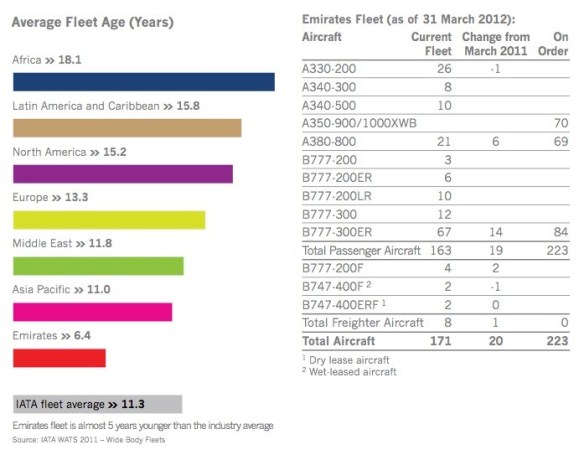The second annual environmental report by the Emirates Group is evidence of the massive cost advantages airlines can get from a young fleet and an enterprise wide green action plan.
It shows that in the year to 31 March the 163 wide body jets in the Emirates fleet burned 22.5% less fuel measured in terms of litres per passenger kilometres flown than the IATA global average as well as emitting more than 18% less fossil sourced carbon by the same metrics.
That is a stunning savings, which Emirates credits above all to its most fuel efficient airliner, the Boeing 777-300ER of which it had 67 in service and 84 on order by the end of the year under review.
In the same period Emirates had 21 Airbus A380 in service, with a further 69 on order. With another order for 70 high composite Airbus A350s on its books, a strong interest in a potential 777-X family, and a desire for an even larger version of the A380 also on the public record, this report is an astonishing way of looking at a global carrier that is more famous, or infamous, in the industry for leveraging the location of its Dubai hub, and the tax free policies of rulers determined to achieve economic ambitions to secure the future.
For an airline group like Qantas, which is itself highly engaged in carbon reduction initiatives, the savings Emirates posts in this financial style audited report would have been around $1 billion (although how this might be adjusted for hedging costs is unknown) over a 12 month period, which would be a phenomenal advantage to an airline under severe pressure.
But the key to the savings Emirates details, and the benefits to the environment, are inextricably linked to something Qantas, and many other carriers, cannot currently fund, which is the latest airliner technology on a large and rapidly renewed basis.
The Emirates fleet overview and its average jet age compared to the rest of the world is graphically summarised below.

When measured in terms of litres/100 passenger kilometres flown, the Emirates fuel efficiency is measured at 4.11, compared to Lufthansa on 4.2, United+Continental 4.25, Finnair 4.62, and Cathay Pacific+Dragonair 4.75. The IATA calculated global fleet fuel efficiency metric in the same was 5.3 litres/100 passenger kilometres flown, making Emirates 22.5% more efficient than the rest of the world on average when it came to fuel burn.
That’s an advantage that on its own would deliver an extraordinary dividend, even if hypothetically, it was based at the end of the line, in Sydney, as Qantas often reminds us, or in Johannesburg, or Santiago.
The report reinforces the critical importance to airline finances, as well as the environment, of fuel efficient fleets. It would also add to the case that the Australian carriers could always press for a depreciation reform to assist our flag carriers to compete on a more equal footing in the world market.







Crikey is committed to hosting lively discussions. Help us keep the conversation useful, interesting and welcoming. We aim to publish comments quickly in the interest of promoting robust conversation, but we’re a small team and we deploy filters to protect against legal risk. Occasionally your comment may be held up while we review, but we’re working as fast as we can to keep the conversation rolling.
The Crikey comment section is members-only content. Please subscribe to leave a comment.
The Crikey comment section is members-only content. Please login to leave a comment.